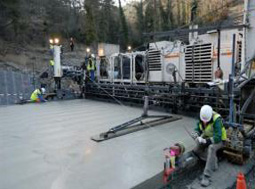Concrete road surface makes a comeback in Spain
FCC ran a successful demonstration at the site of road C-17 in Barcelona

FCC conducted a demonstration of rigid road surface at the site of the work to twin, upgrade and generally improve road C-17 in Barcelona. FCC was accompanied at the demonstration by the Department of Territorial Policy and Public Works of Catalonia and its publicly owned company Gestión de Infraestructura (GISA).
The surface demonstration project, an FCC Group initiative, concluded as a resounding success after several days' work. The surface was laid on a section of the road where Les Masies de Voltregà and the junction with road BV-4655 are located. The section is a kilometre long and includes stretches outdoors as well as in tunnels. The new roadway has two 3.5-metre-wide lanes, a one-metre-wide inner verge and a 2.5-metre-wide outer verge.
The surface was built by placing 25 centimetres of concrete on top of a 25-centimetre layer of cement-stabilised material to form the crown on top of the graded area. Between the two layers, five centimetres of hot bituminous mixture was poured to keep water from infiltrating the joints. Water would combine with the action of traffic to reduce the graded surface's bearing capacity and stability, causing damage to the graded area and negative repercussions for surface durability.
The road's surface was laid in two layers. First, a concrete spreader lay the bottommost 20 centimetres of the concrete layer. Then, a second machine coordinated with the first spread the remaining five centimetres of the roadway surface. This procedure ensured adherence between the two layers.
Through the application of a chemical compound followed by scouring, aggregates were exposed on the road surface, giving a better macrotexture and producing less tyre noise.
Concrete surface technology has made some dizzying progress in the last 15 years, so far as to have replaced traditional asphalt surfaces in the construction of dual carriageways in numerous developed countries (the USA, Belgium, Austria, Germany, Argentina).
FCC has a great deal of experience in concrete surface laying through its Austrian subsidiary Alpine, which has applied this solution in a multitude of projects in central Europe.
Running demonstration projects like this can open the way to a revival of concrete surface designs in Spain, where concrete surfaces were practically abandoned 20 years ago. This is certainly excellent news for the cement industry and for the environment, given the considerable ecological advantages this type of material has to offer.
The advantages of concrete
Concrete surfaces have recognised advantages, which testify to their being one of the best solutions not only technically, but economically and environmentally as well.
Some of the advantages are well known, including include concrete's long useful life in different climates and service conditions, its low maintenance cost, its ease of construction with simple, energy-efficient equipment, its stability and anti-slip features and its resistance to aggressive agents. In addition, there are the reflective qualities of concrete, which mean that a concrete surface provides much better night-time visibility and thus safer driving conditions.
In its publication entitled, "Concrete Roads: A Smart and Suitable Choice", the European Concrete Paving Association brings international experience to the fore to show that concrete paving is a viable solution for attaining sustainable construction, and that it satisfies the basic requirements of environmental, economic and social friendliness.
Today experts consider that concrete paving needs to be used more often. Concrete is a one-hundred-percent recyclable material and one of the strongest road-building solutions there is.
In addition, because concrete does not warp, it reduces vehicle fuel consumption by an average of 3.5% for heavy vehicles and 1.2% for light vehicles. That means lower CO2 emissions.








